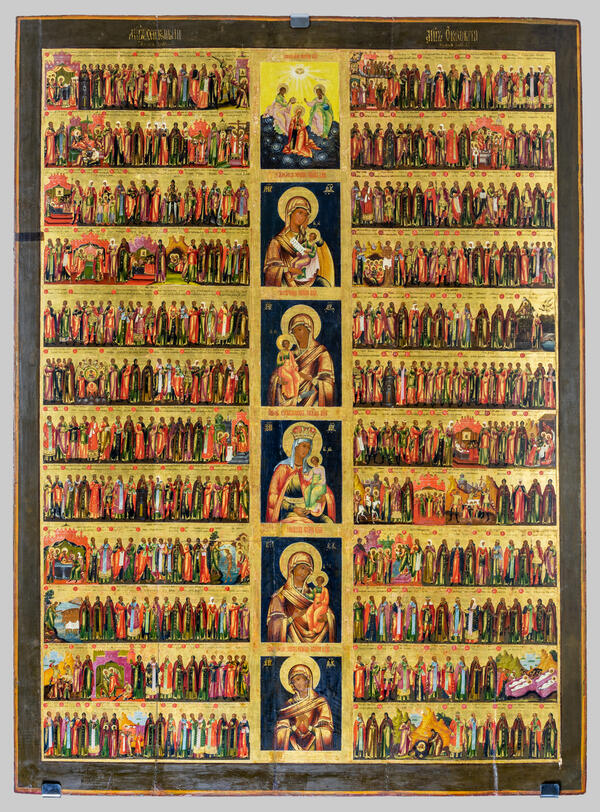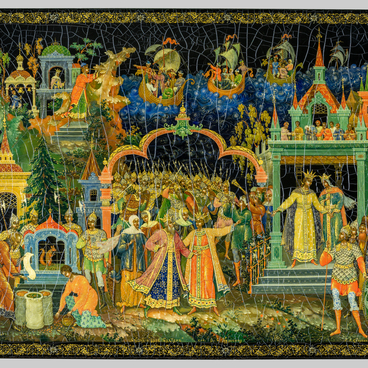The Palekh artists often painted calendar icons called the Menaia. The calendar system that appeared in Russia after the adoption of Christianity was an important part of church life. Believers honored the memory of many saints, both Byzantine and Russian.
The Christian holidays were described in Byzantine books. They featured short descriptions of the lives of the saints and indicated on which days to hold services dedicated to them. The dates were written in calendar order, by day. Such books were called prologues, torzhestvenniks (lit.: solemn books), patericons, and Menaia. They inspired the creation of the Menaion icons.
The Six-Month Menaion from the collection of the State Museum of Palekh Art was painted in 1850. The date is written on the back of the board. The icon covers the period from September to February. It is vertically divided into two parts. In the center we can see the most famous icons of the Mother of God: Coronation of the Virgin, Soothe my Sorrows, Trojeručica (lit.: Three-Handed), Deliverance of the Suffering from their Troubles, Panagia Portaitissa, and the Softening of Evil Hearts. The images are surrounded on both sides by the figures of saints with the dates of Christian holidays written above them.
In the Old Russian calendar, September started the year. It was in use since 1343 and was based on the calendar of the Church of Alexandria. In 1700, Peter the Great ordered to move the beginning of the year to January 1, but, despite the imperial order, the Old Believers kept following the established traditions. In the Minaion from the collection of the State Museum of Palekh Art, the year also begins in September. The saints celebrated during a particular month are located in the upper left corner. Each month is represented by four lines.
This icon is a typical example of Palekh miniatures of the mid-19th century. Despite the fact that the icon is filled with the images of chambers, figures, and landscape elements, it looks whole and not overloaded. The unknown artist painted the saints in relaxed poses. He chose the proportions correctly and painted the images in a soft and light manner while creating the illusion of volume.
The folds of the robes are lined with gold, from the oval spot on the knees to the long, ray-like strokes. The author used traditional techniques to paint the faces of the saints. First, he applied a dark olive sankir. In icon painting, the word sankir is used to describe a colorful layer of brown, greenish, or brownish-pink color used to cover the faces and hands of the saints at the first stage of creating an icon. Then he covered the sankIr with layers of ocher with gradual lightening.
The color scheme is dominated by the traditional Palekh colors: ocher, brown, red-brown, vermilion, blue-black, and green. The artist mixed many shades with white paint, making the icon visually lighter. The Palekh artists paid great attention to the harmony of colors, which largely contributed to the wholeness of local icons, including this Menaion.
The Christian holidays were described in Byzantine books. They featured short descriptions of the lives of the saints and indicated on which days to hold services dedicated to them. The dates were written in calendar order, by day. Such books were called prologues, torzhestvenniks (lit.: solemn books), patericons, and Menaia. They inspired the creation of the Menaion icons.
The Six-Month Menaion from the collection of the State Museum of Palekh Art was painted in 1850. The date is written on the back of the board. The icon covers the period from September to February. It is vertically divided into two parts. In the center we can see the most famous icons of the Mother of God: Coronation of the Virgin, Soothe my Sorrows, Trojeručica (lit.: Three-Handed), Deliverance of the Suffering from their Troubles, Panagia Portaitissa, and the Softening of Evil Hearts. The images are surrounded on both sides by the figures of saints with the dates of Christian holidays written above them.
In the Old Russian calendar, September started the year. It was in use since 1343 and was based on the calendar of the Church of Alexandria. In 1700, Peter the Great ordered to move the beginning of the year to January 1, but, despite the imperial order, the Old Believers kept following the established traditions. In the Minaion from the collection of the State Museum of Palekh Art, the year also begins in September. The saints celebrated during a particular month are located in the upper left corner. Each month is represented by four lines.
This icon is a typical example of Palekh miniatures of the mid-19th century. Despite the fact that the icon is filled with the images of chambers, figures, and landscape elements, it looks whole and not overloaded. The unknown artist painted the saints in relaxed poses. He chose the proportions correctly and painted the images in a soft and light manner while creating the illusion of volume.
The folds of the robes are lined with gold, from the oval spot on the knees to the long, ray-like strokes. The author used traditional techniques to paint the faces of the saints. First, he applied a dark olive sankir. In icon painting, the word sankir is used to describe a colorful layer of brown, greenish, or brownish-pink color used to cover the faces and hands of the saints at the first stage of creating an icon. Then he covered the sankIr with layers of ocher with gradual lightening.
The color scheme is dominated by the traditional Palekh colors: ocher, brown, red-brown, vermilion, blue-black, and green. The artist mixed many shades with white paint, making the icon visually lighter. The Palekh artists paid great attention to the harmony of colors, which largely contributed to the wholeness of local icons, including this Menaion.



